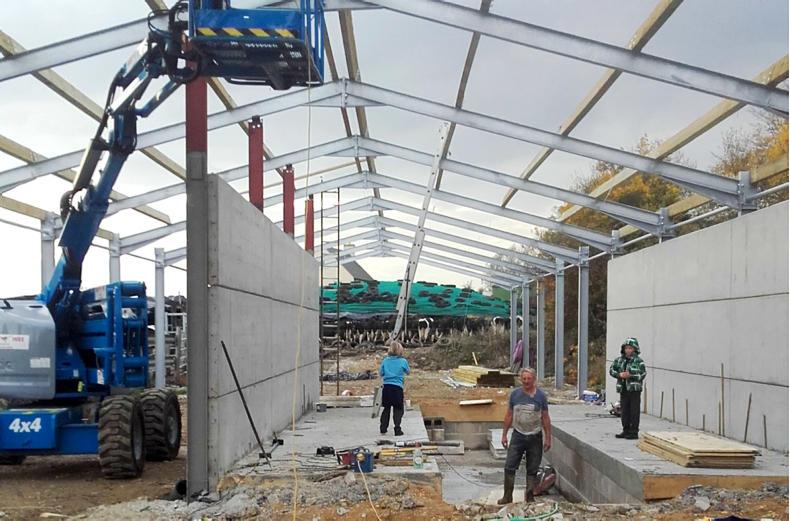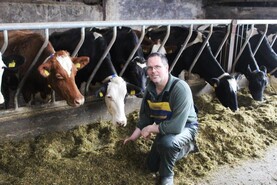We are currently using farm labour to construct the building for a new collecting yard and milking parlour. We have taken on a young lad to do the milking who has proved invaluable.
This has allowed us to concentrate on the project and avoid the herd being neglected due to increased workloads. This has happened in the past, where any savings made on the project are offset by the herd underperforming due to lack of attention.
Once you have built a milking parlour, the next one would be easy. It is the first where you make all your mistakes. We have built three, which cost time and money, but at least we were able to rectify them before the building was finished.
Next time, I would employ a professional to come in and check measurements and levels twice a week. The main problem this time is that my son-in-law works in metric, while I work in imperial!
Standings dilemma
Our biggest dilemma was the height of the standings. Our current parlour is only 30in high. The relief milker told us that 36in was too high due to muck splatter. The Irish Farmers Journal recently had an article which stated 34in was ideal. Four inches higher seemed a big step to us, so with rubber matting we will end up at 33in.
We did manage to get a fall on the standings and pit floor from exit to entry, but it did take some working out. At one point it looked like the standings would slope one way and the pit slope another.
No grass in August and poor quality silage meant cows did not milk well
On the farm front, the last heifer calved six weeks out of sync. Dead calf, swollen head and one leg out. She then decided to go sick and give little milk – she is now suckling.
No grass in August and poor quality silage meant cows did not milk well. There was a slight flush of grass in September, but with the cows on grass and as much good quality silage as they will eat, together with brewers grains, we are still failing to protect the peak of the autumn calvers.
It is as if the cows and grass are exhausted after a very productive summer
Other people say their cows aren’t milking well either. It is as if the cows and grass are exhausted after a very productive summer.
I am probably tempting fate by saying that milk fever has not been a problem so far. Each cow gets a calcium drink as soon as she calves and a calcium bolus if she doesn’t look right. For the first time we have given the dry cows a mineral lick. This is placed in a container with the top cut off and half filled with stones, hopefully to deter the badgers.
Expensive extra litres
I’m very pleased to see my milk buyer is paying 25p/l for B litres, but I am afraid it is too late to throw money at us and expect an increase in milk supply. Producers have haemorrhaged too much money in the last 18 months and hopefully have learnt a hard enough lesson to deter them from chasing the elusive expensive extra litres.
From the other end of the table: we have joined the milk reduction scheme, which may alleviate the financial pain, and our magnesium soil levels are always over five, which is why we have to be careful with milk fever.
Read more
Farmer writes: Joe’s stories
We are currently using farm labour to construct the building for a new collecting yard and milking parlour. We have taken on a young lad to do the milking who has proved invaluable.
This has allowed us to concentrate on the project and avoid the herd being neglected due to increased workloads. This has happened in the past, where any savings made on the project are offset by the herd underperforming due to lack of attention.
Once you have built a milking parlour, the next one would be easy. It is the first where you make all your mistakes. We have built three, which cost time and money, but at least we were able to rectify them before the building was finished.
Next time, I would employ a professional to come in and check measurements and levels twice a week. The main problem this time is that my son-in-law works in metric, while I work in imperial!
Standings dilemma
Our biggest dilemma was the height of the standings. Our current parlour is only 30in high. The relief milker told us that 36in was too high due to muck splatter. The Irish Farmers Journal recently had an article which stated 34in was ideal. Four inches higher seemed a big step to us, so with rubber matting we will end up at 33in.
We did manage to get a fall on the standings and pit floor from exit to entry, but it did take some working out. At one point it looked like the standings would slope one way and the pit slope another.
No grass in August and poor quality silage meant cows did not milk well
On the farm front, the last heifer calved six weeks out of sync. Dead calf, swollen head and one leg out. She then decided to go sick and give little milk – she is now suckling.
No grass in August and poor quality silage meant cows did not milk well. There was a slight flush of grass in September, but with the cows on grass and as much good quality silage as they will eat, together with brewers grains, we are still failing to protect the peak of the autumn calvers.
It is as if the cows and grass are exhausted after a very productive summer
Other people say their cows aren’t milking well either. It is as if the cows and grass are exhausted after a very productive summer.
I am probably tempting fate by saying that milk fever has not been a problem so far. Each cow gets a calcium drink as soon as she calves and a calcium bolus if she doesn’t look right. For the first time we have given the dry cows a mineral lick. This is placed in a container with the top cut off and half filled with stones, hopefully to deter the badgers.
Expensive extra litres
I’m very pleased to see my milk buyer is paying 25p/l for B litres, but I am afraid it is too late to throw money at us and expect an increase in milk supply. Producers have haemorrhaged too much money in the last 18 months and hopefully have learnt a hard enough lesson to deter them from chasing the elusive expensive extra litres.
From the other end of the table: we have joined the milk reduction scheme, which may alleviate the financial pain, and our magnesium soil levels are always over five, which is why we have to be careful with milk fever.
Read more
Farmer writes: Joe’s stories






 This is a subscriber-only article
This is a subscriber-only article










SHARING OPTIONS: